| |
| ... |
|
|
|
|
|
| |
| December 7, 2003 |
|
Weekend 10 — A Chilly End.
Hunkered down here after a weekend of snow and shoveling, I had totally forgotten that the season's final weekend had been in progress. An email from Pat provided the chilling details of the weekend. She wrote:
Saturday. Members of the Montgomery County Gem, Lapidary and Mineral Society (MD), who left home with six inches of snow on the ground, thought they were in a heat wave. The rest of us however, suffered through a morning temp of 37 degrees (wind chill of 29) and a day of cloudy skies. Even through watery eyes, a few good finds were made in Block 26A.
Eric Thompsen managed to find a pristine black chubutensis (3 + inches). Other complete but smaller ones were found by Melissa Thompsen and Rita McDaniel. Darlene Nethercut thought she'd found an outstanding large Yorktown meg, unfortunately, it was minus the root. The "mako" of the day was Ron Edwards' 2-1/8" "xiphodon", but Melissa got a large pathological lateral. Three lower Notorynchus were found (John Bullett, Ted Kordela & Rich Olsen) and a Carcharodon carcharias (Chris Herbstritt). Some of the interesting non-shark finds included a crocodile tooth (Sharron Edwards), huge horse tooth (Courtney Lowe), smaller horse tooth (Rita McDaniel), juvenile seal humerus (Darlene Nethercut), whale tooth (Paul Saery), and dugong rib (Chris Herbstritt). Most of the day's better finds were in areas that had recently been extended from the old collecting areas.
Sunday. Twenty-six hardy souls from the Friends of the Maritime Museum (NC), the Coastal Cartaret Science Club (NC) and some unaffiliated collectors gathered Sunday. A morning temp of 28 degrees, 10 to 20 mph wind gusts and ground frozen to a depth of 1-1/2 inches made collecting very difficult. Although we had planned to start the day at the NCPC cut, when we arrived there, the dragline was busy piling up tons of Yorktown material at the edge of the plot. Most of us were hoping for a bus breakdown at that point, but... Becky moved us to Block 26 B and we proceeded to do the best we could — all hoping for that elusive meg (after all, this was the last day of the season).
Biting winds kept most eyes running. The one meg of the day was a 1-1/2 incher found in a bulldozer track. It was a beautiful, pristine Pungo lateral. I saw a few nice "makos" and hemis, but it was mostly small Carcharhinus teeth. One nice whale radius of about 18 inches was found. A few people did manage to pry some fish verts and a few nice shells from the frozen earth. By 1PM the bus had filled with collectors who had decided to wait until the spring to try their luck. We departed at 2PM with hopes for an early, warm spring.
|
| November 24, 2003 |
|
Weekend 9 — A Bear in the Bush
Saturday. There were about forty visitors, made up of both individuals and members of the Delaware Valley Paleo Society, Calvert Marine Museum & Suanee Creek Fossil Club. A couple of inches of rain during the week provided hope for good collecting and the weather attempted to cooperate — sunny and in the seventies. The only obvious benefit of the rain was an outstanding trackway (Urus americanus) through the center of Block 26a (figs. A & B), otherwise, collecting was on a par with recent results. Most of the day's better finds came from newly opened tailings on the backside of the hill (small but productive).

Seldom does the Lee Creek highlight-of-the-day be non-paleo in nature, however on this trip, a black bear trackway (several yards, fig. D) on the main road through the site managed to garner that honor. Runner-up, and certainly Find-of-the-day, was Mary Lightfoot's seal molar (fig. C). "Megs" barely edged-out "makos" for largest-tooth-of-the-day honors. Representing the megatoothed sharks were C. chubutensis by Rita McDainiel (3"), Ron Keil (2-1/4", fig. E) & Frank Elder (SCFC, 1-5/8") and a megalodon by Mike Keklak (DVPS, 2-1/4"). A number of smaller great whites and makos were found, the larger being Zandra Elder's hastalis uA2 (2-1/4"), Eric Thompsen's hastalis (1-3/4"), Thomas McKeeman's (DVPS) C. carcharias (1-3/4"), and couple 2-inch lower anterior makos by Mike Luce & Carol Veigle.

Notorynchus of note were Clara Jo Elder's upper parasymphyseal, Melissa's upper lateral and Thomas McKeeman (DVPS) gorgeous lower lateral (fig. G). Ken Young managed to find a nice bramble, but it was otherwise slow pickings of Galeocerdo, Carcharhinus and Carcharias teeth.

If Pat were asked, she'd probably have noted some great inverts — she wasn't. Dianna Hinshaw (ODESS VA Beach) found a croc tooth, Lucas Crain (SVFC) a great ?dolphin periotic (1-3/4", fig. F) and Richard Habron (Calvert Marine Museum) a very nice chunk of copal. Serious hunting required traipsing through tall weeds; leaving many collectors covered in spider silk — does life get better?
Sunday. North Carolina provided all another beautiful November day — sunny and in the mid-seventies. Thirty-one fossil collectors showed-up to search the NCPC site (morning) and Block 26B (afternoon). Pat reports:

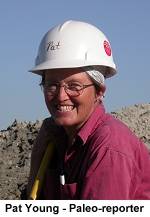 The new dirt placed by the company at the entrance to the NCPC collecting site managed to produce four large whale verts, two bullas and one large periotic. Several "mako" teeth and one black meg (minus root, but still 4 inches long) were also found in that dirt. The older NCPC area managed to produce two small sperm whale teeth and the usual assortment of "makos", Hemis, etc. I saw one nicely pathological contortus tooth and a very nice ray scute. (The abundance of shrubby overgrowth makes that area hard to collect.) The new dirt placed by the company at the entrance to the NCPC collecting site managed to produce four large whale verts, two bullas and one large periotic. Several "mako" teeth and one black meg (minus root, but still 4 inches long) were also found in that dirt. The older NCPC area managed to produce two small sperm whale teeth and the usual assortment of "makos", Hemis, etc. I saw one nicely pathological contortus tooth and a very nice ray scute. (The abundance of shrubby overgrowth makes that area hard to collect.)
At noon we moved to Block 26B (fig. H) to see what the rain had exposed. It produced many more teeth than the previous area. Vince O'Donnell found a beautiful 4-7/8" megalodon. (Unfortunately, it was missing a corner of the root, but its' shield-shape still made for an impressive specimen.) Rich Olsen found a 2-5/8" "xiphodon" and Candace Holliday a 1-3/4 inch one (quite a few smaller ones were also found). Yvonne Pribyl picked a small lower Carcharodon carcharias. Several nice Notorynchus lowers and one Hexanchus upper were also found. Other notable finds included a complete seal molar (Becky Hyne), shark cartilage, large fish tail, and some nice fish vertebrae that had been recently exposed by the rain.
|
| November 16, 2003 |
|
Weekend 8 — It Takes More Than a Rainbow
Saturday's group consisted of the Maryland Geological Society, Grand Strand Fossil Club and a group of instructors from the Hampton (VA) School District. The cool morning started off with a beautiful rainbow in the west — would there be a pot of megs? Unfortunately, last weeks diligent collecting made for some scarce pickings today. Both areas of Block 26 were collected, but with no rain this past week it was difficult. Pat Young reports.
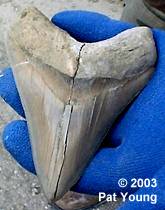 A few good finds were made including two brambles (Becky and Paul Borodin). Becky also found a Squatina and John Everette a nice posterior meg (2-7/8"). Several large "makos" turned-up, including a nice lateral by Melissa, and nice lowers by Rod Battenfeld and Russ Byers. Alice Healy found a great Isistius lower and several nice Notorynchus were also found by others. The heartbreaker of the day had to be John Adams' almost perfect blond megalodon — unfortunately, a bulldozer had split it in half. (It fitted back together nicely.) Other notable finds included Russ Byers 5-inch bird ulna, Rich Olsen's porpoise ulna, and Dave Grabda's sperm whale tooth. Two great keyhole limpets (both rare finds) were made also found. Otherwise, it was mostly the usual smaller tigers, Hemis and Carcharhinus teeth. A few good finds were made including two brambles (Becky and Paul Borodin). Becky also found a Squatina and John Everette a nice posterior meg (2-7/8"). Several large "makos" turned-up, including a nice lateral by Melissa, and nice lowers by Rod Battenfeld and Russ Byers. Alice Healy found a great Isistius lower and several nice Notorynchus were also found by others. The heartbreaker of the day had to be John Adams' almost perfect blond megalodon — unfortunately, a bulldozer had split it in half. (It fitted back together nicely.) Other notable finds included Russ Byers 5-inch bird ulna, Rich Olsen's porpoise ulna, and Dave Grabda's sperm whale tooth. Two great keyhole limpets (both rare finds) were made also found. Otherwise, it was mostly the usual smaller tigers, Hemis and Carcharhinus teeth.
Correction. Eric pointed out that last weekend's sea urchin was an Arbacia improcera and not the Psammechinus philanthropus as previously reported.
|
| November 9, 2003 |
|
Weekend 7 — Some Improvement
Well, the mine had another couple inches of rain over the week, which on top of the previous week's, appears to have improved this weekend's results. Pat Young reports:
November 8th. Fifty degree temperatures and a 20 knot wind greeted 31 fossil collectors from the Columbia (SC) Gem & Mineral Society, Columbus (SC) Rock & Mineral Society, Georgia Gem & Mineral Society and American Fossil Federation.
Searching through the past diggings of other collectors paid off for Eric Thompsen. He found a Hexanchus symphyseal (25mm wide) and a perfect Isistius lower (approx. 6mm high). The largest "mako" of the day was found by Becky (2"). 1-1/2 inchers were found by Scott Kell, BJ Blake (2), and Candace -- quite a few smaller laterals were also seen. Notorynchus lowers were found by Melissa Thompsen, BJ, and Scott. Melissa also found a Notorynchus upper. Bonney Weathers found an outstanding Hexanchus upper. Some really nice cuviers had been exposed by the rain including one with a cusp on the mesial side of the crown. Partial brambles were picked by Becky and Melissa while Brady Hamilton got a "contortus" symphyseal. BJ brought out a piece of shark cartilage.
The mammal finds of the day included a perfect whale humerus dug out by Scott Shrader, a complete thoracic porpoise vertebra (Scott Kell), a large whale vertebra (George Poulin) and two associated cervical vertebrae (Carl Davis). Tom Peard found a horse tooth. Some partial bird bones were also recovered during the day. The invert category was well represented by Tom Newquists' beautiful cup and saucer shell.
November 9th. Brisk winds of 30 mph and 48 degree weather greeted fossil collectors on Sunday. Visitors from the Tarheel Gem & Mineral Society (NC), Catawba Valley Gem & Mineral Club (NC), Dahlgren Fossil Club (VA) and two unaffiliated groups started off the day's collecting at the NCPC site. Some new tailings had been moved into this site and a bulldozer had pushed around other areas, but it needs additional rain to wash it off. Two large whale verts were recovered from the muck, but most finds were in the more settled areas. The roadsides produced a 3-inch Pungo meg (Bob Crocker) and a seal canine (Baxter Leonard). The usual "mako", sand tiger, and hemi teeth were found, apparently washed out by the rain. Tom Hymer found an extremely large, complete sea urchin (Psammechinus philothropus) with its spines (disarticulated).
At 11:30 we moved to Block 26A. Even though the area is much smaller than earlier in the season, it still produced some good finds. Eric Herbert found a 9-point Hexanchus lower, Bob Crocker a small Pungo Paratodus and David Elliott brought out a stunning 2-1/2 inch UA2 "xiphodon". Lots of smaller "mako"-types were found, including nice ones by Jim Seamon, Wayne Bowman and Mark Jones. Mark also found a 3-inch meg which had seen some damage. Marge Noel found her 2-inch lower "mako" the lazy way (in the mine parking lot's reject dirt). Notorynchus lowers were found by Bob Crocker and Richard Altman, and Leslie Barteaux got a nice upper. Several large cuviers and hemis were recovered. It seemed that everyone had lots of teeth this day even if mostly smaller in size. Steve Noel brought out a large double myliobatid scute. All-in-all, it was a good day for fossiling and visiting.
|
| November 3, 2003 |
|
Weekend 6 — Teeth Still Slow
This Saturday's thirty visitors were made up of members from the NC Shell Club, Vidalia Fossil Hunters Club (Georgia) and High Point Mineral Club (NC). It was a generally pleasant day for collecting, starting in the 50's and rising to 80 degrees. Better yet, the mine had received good rain during the week (4-inches of rain in one 24-hour period), Collecting began in Block 26A and switched over to 26B at noon. Pat reports
Jim White was the day's "winner" with two 'xiphodon' (2-1/4" upper) and (2" lower) teeth from Block 26A followed by two chubutensis (1-3/4" and 2") from 26B. He also collected five associated bones, including a complete coracoid, of a large bird. From 26A, John Timmerman lugged out a 50lb. piece of phosphate matrix ("get it before it gets gone"), Candie Davies brought out a huge section of whale skull and Will Ouimet a portion of a smaller skull (porpoise?).
At 26B we had hoped to fare better considering last weeks' report of two Megachasma teeth being found. Even with all the rain and washing of slopes, the larger teeth were scarce. Blair Hall did manage to find a nice Carcharodon carcharias (2") and Anna-rhesa Kallam found an extremely large and pristine Pungo Hemipristis upper lateral. The other teeth were all smaller mako types, a few cuviers and lots of Carcharhinus. We had all hoped for a bramble, but not the case this time. Sharron Edwards did manage to find a larger than average Pungo Squatina tooth and Ron Edwards a large Dasyatis dermal scute, which was in super condition. Becky found a 6" bird ulna (complete) and Dulcie Hall a pilot whale tooth. Surprisingly, a few whale vertebrae surfaced even though no teeth were found.
Although we had been blessed with good rains, teeth were elusive at both locations. Shell collectors and bone hunters fared much better — most of them left with buckets full of whale bones and some nice pecten shells.
|
| October 29, 2003 |
|
Weekend 5 — Updates
Believe it or not, a second Megachasma tooth was found last weekend! Keith Robertson (President, Delaware Mineralogical Society) dropped me a note to say that, "one of our newer members, Blair Venables, also found a Megamouth on Sunday! He picked it up, not knowing what it was, and during the group wash-and-identify session on Sunday eve at the hotel, he showed it to me. Two megamouths in one day? ... Our group also found 4 Bramble denticles."
Pat Young also advised, "my shell turned out to be not a Scotch Bonnet. I'm not sure what it is." This means it's still been twenty years since one of these has been reported from the mine.
|
| October 27, 2003 |
|
Weekend 5 — The James City Crawl
It's great having second party reports, but there's nothing like getting a personal perspective of the Lee Creek collecting. I finally had the opportunity to do so this last weekend. There had been no rain since the last round of collecting, so there were no rosy glasses for these observations. The net results are that for longtime collectors it's tough, but first timers should have a good time. (Note: specimen images not similarly scaled.)

October 25.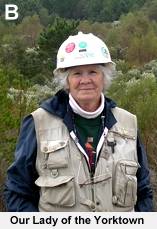 The weather was generally good (60s) for the 34 North Carolina aquarium visitors (mostly Fort Fisher Aquarium) but a misty rain arrived after noon. Collecting was in the NCPC cut, which has greatly shrunk since last season. For all practical purposes, this may now be described as a long (maybe 4-500 yards) dirt road with a side bank (4-8 feet high) of tailings (ref image A). There are Yorktown and Pungo sections, but it seems to be predominated by James City intermixed with some Pungo. There are few exposures that one could reliably ascribe a stratigraphic context to a specimen. These exposures had been previously collected with no intervening rain, so the day called for kneepads and the "James City crawl". Even longtime collectors (names omitted to protect reputations) were picking invertebrate material (and proud of it). Although I might chide those like Pat that prefer the invertebrate fauna, it is damn good at Lee Creek and this is giving others the chance to sample this fauna. [BTW: For those closet invertebrate collectors out there (you know who you are), Pat traded for a Scotch Bonnet that was found this day! Does life get better?] The weather was generally good (60s) for the 34 North Carolina aquarium visitors (mostly Fort Fisher Aquarium) but a misty rain arrived after noon. Collecting was in the NCPC cut, which has greatly shrunk since last season. For all practical purposes, this may now be described as a long (maybe 4-500 yards) dirt road with a side bank (4-8 feet high) of tailings (ref image A). There are Yorktown and Pungo sections, but it seems to be predominated by James City intermixed with some Pungo. There are few exposures that one could reliably ascribe a stratigraphic context to a specimen. These exposures had been previously collected with no intervening rain, so the day called for kneepads and the "James City crawl". Even longtime collectors (names omitted to protect reputations) were picking invertebrate material (and proud of it). Although I might chide those like Pat that prefer the invertebrate fauna, it is damn good at Lee Creek and this is giving others the chance to sample this fauna. [BTW: For those closet invertebrate collectors out there (you know who you are), Pat traded for a Scotch Bonnet that was found this day! Does life get better?]

 Although no one walked out with huge specimens or large quantities of shark teeth, these previously picked tailings did provide all with something. The largest (complete) tooth of the day was John Everette's 2-inch chubutensis, although Howie Cohn (ref image G) had a much larger reworked example. Hastalis teeth were generally small and hard to find, Pat Holleman (FFA) had the best (a perfect 1-1/2 incher) although Keith Register (FFA) and Shane Cook (Aquarium at Manteo) also had nice specimens. A half dozen Notorynchus were reported, but otherwise it was the "usual suspects". Even though James City sediments were abundant, only a single C. carcharias tooth was recovered (ref image D). Melissa did well finding a nice pilot whale tooth and a great sand dollar (ref image E, Eric also got one), but the top find was Keith Farmer's porpoise jaw section (ref image E). Most interesting item might have been by Mary Crowder. She picked up a scallop valve, turned it over, and rather than seeing "Sorry you are not a winner, try again", there was a meg posterior (ref image C). After heavy rains, the NCPC cut should continue to produce, but it is very close to being picked/bulldozed out of existence. Although no one walked out with huge specimens or large quantities of shark teeth, these previously picked tailings did provide all with something. The largest (complete) tooth of the day was John Everette's 2-inch chubutensis, although Howie Cohn (ref image G) had a much larger reworked example. Hastalis teeth were generally small and hard to find, Pat Holleman (FFA) had the best (a perfect 1-1/2 incher) although Keith Register (FFA) and Shane Cook (Aquarium at Manteo) also had nice specimens. A half dozen Notorynchus were reported, but otherwise it was the "usual suspects". Even though James City sediments were abundant, only a single C. carcharias tooth was recovered (ref image D). Melissa did well finding a nice pilot whale tooth and a great sand dollar (ref image E, Eric also got one), but the top find was Keith Farmer's porpoise jaw section (ref image E). Most interesting item might have been by Mary Crowder. She picked up a scallop valve, turned it over, and rather than seeing "Sorry you are not a winner, try again", there was a meg posterior (ref image C). After heavy rains, the NCPC cut should continue to produce, but it is very close to being picked/bulldozed out of existence.


October 26.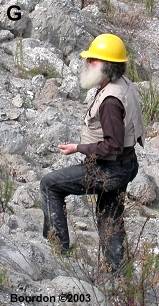 The better of the remaining collecting areas is Block 26 (new). It is a high ridge maybe 150 yards in length with excellent Yorktown and Pungo River sediments. Concentrated collecting and raking has taken a toll, and without rain, this weekend's 26 visitors (Aurora Fossil Club, NJPS and Delaware Mineral Society) had a hard time finding targeted specimens. It was a deceivingly warm day (70s) and mosquitoes rendered careful collecting, particularly in the lower areas, quite difficult. I found it disheartening to crawl through Pungo sands that would traditionally produce 100s of teeth and only find a few isolated specimens — these exposures have been worked and reworked. This of course does not mean nothing can be found. Soon after departing the bus, Louise Slate (AFC) picked the specimen of the day, a beautiful Megachasma tooth (ref image H, height 11/16", width 9/16") and then found a delicate Cetorhinus-like gillraker (length 9/16", ref image E). Some redirected their attentions to invertebrates, and myself to Yorktown otoliths (a few dozen). If collecting conditions continue on the present course, visitors should change their mindsets and target other fossil material (not just large shark teeth). The better of the remaining collecting areas is Block 26 (new). It is a high ridge maybe 150 yards in length with excellent Yorktown and Pungo River sediments. Concentrated collecting and raking has taken a toll, and without rain, this weekend's 26 visitors (Aurora Fossil Club, NJPS and Delaware Mineral Society) had a hard time finding targeted specimens. It was a deceivingly warm day (70s) and mosquitoes rendered careful collecting, particularly in the lower areas, quite difficult. I found it disheartening to crawl through Pungo sands that would traditionally produce 100s of teeth and only find a few isolated specimens — these exposures have been worked and reworked. This of course does not mean nothing can be found. Soon after departing the bus, Louise Slate (AFC) picked the specimen of the day, a beautiful Megachasma tooth (ref image H, height 11/16", width 9/16") and then found a delicate Cetorhinus-like gillraker (length 9/16", ref image E). Some redirected their attentions to invertebrates, and myself to Yorktown otoliths (a few dozen). If collecting conditions continue on the present course, visitors should change their mindsets and target other fossil material (not just large shark teeth).

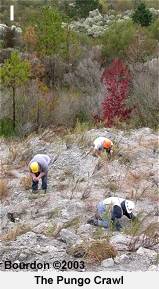 The days largest shark tooth was Debra Sansone's (NJPS) 2-inch hastalis (broad form), and for Carcharocles, it was Montgomery Lentz's 1-1/4" chubutensis. Mat Lentz picked two Notorynchus, the largest (ref image H) was as large as the day's biggest "meg" — I wonder how often that has ever happened? The usual assemblage of shark teeth was recovered, albeit in lower numbers. Some seal and bird material was recovered, and Keith Robertson (DMS) had a nice portion of lower porpoise jaw (left & right fused at the symphysis). Long time collectors were very disappointed in the day, but first timers, such as Sophie Homsey, were beaming over the great collecting. My (and other's that asked not to be mentioned by name) initial dissapointed changed after redirecting my attention to those otoliths. My recommendation would be to continue visting when the opportunity presents itself, but to remove that big meg or "mako" tooth from the mindset — there still is a great fauna to be sampled. The days largest shark tooth was Debra Sansone's (NJPS) 2-inch hastalis (broad form), and for Carcharocles, it was Montgomery Lentz's 1-1/4" chubutensis. Mat Lentz picked two Notorynchus, the largest (ref image H) was as large as the day's biggest "meg" — I wonder how often that has ever happened? The usual assemblage of shark teeth was recovered, albeit in lower numbers. Some seal and bird material was recovered, and Keith Robertson (DMS) had a nice portion of lower porpoise jaw (left & right fused at the symphysis). Long time collectors were very disappointed in the day, but first timers, such as Sophie Homsey, were beaming over the great collecting. My (and other's that asked not to be mentioned by name) initial dissapointed changed after redirecting my attention to those otoliths. My recommendation would be to continue visting when the opportunity presents itself, but to remove that big meg or "mako" tooth from the mindset — there still is a great fauna to be sampled.
|
| October 19, 2003 |
|
Weekend 4 — Club Visits Begin
Rich Olsen (president NCFC) was kind enough to drop a note on his club's experience this weekend, he wrote:
Cool temperatures and clouds greeted 32 collectors from NCFC along with two "add-ons", Becky as leader-driver and several guides. Early collecting took place in the large "old" Block 26, later a visit was made to the small newer section. Both areas showed considerable wear from earlier trips and collecting was fair at best with most participants forced to use the 'Pungo Crawl' to make a find. No large megs were found. Smaller "Pungo" megs were found by Dick Marshall (2-1/2") and Ken Young (2-1/2"), Colon Roberts and Brent McGuirt (1" posterior). Several decent "makos" were found including a 2-1/2 incher by Todd Power, three 1-3/4" examples by Joanne Dubrock and a pathological specimen by Val Kreil. Notorynchus specimens were collected by John Everette, Keith Brown and Dick Marshall. Jodi McDaniels picked a nice 2-inch Galeocerdo cuvier. Rarities included Jay Coe's bramble, Jerry Messick's partial sloth tooth and the "find of the day" — John Steffensen's fine megamouth tooth. Hopefully, the mine personnel will employ the bulldozer between now and the next trip, as they did earlier, to renew the potential of this site for future visitors (rain and wind are not enough with the concentrated collecting pressure).
I hope Rich is right about the bulldozer, I'll get my shot next Sunday with the NJPS.
|
| October 12, 2003 |
|
Weekend 3 — Back on Duty
The third weekend was again set-aside for the Friends and our tireless reported was back on watch.
October 11th. A small amount of rain the previous week helped John Keklak (DVPS) to go home a happy man. He found a 3-3/8 inch megalodon, a 1-15/16 inch Carcharodon carcharias and a 2-1/4 inch hastalis. Melissa Thompsen also found a nice Yorktown meg that measured 3-1/4 inches. The usual assortments of other shark teeth were found including some nice Notorynchus. Becky found a Squalodon molar.
October 12th. Although the NCPC site is postage stamp-sized, Becky started off the day there. At 11:00, we moved to Block 26B. Surprisingly, NCPC proved to be the more prolific collecting area. Robert DuBrock found a nice chubutensis and Hamp Henly & George Powell meg posteriors. Kurt Reid found a nice Carcharodon carcharias, Notorynchus and two great 'makos' - one a beautiful lower hastalis. Trish Kohler picked a pretty 'xiphodon' that was nearly transparent and others quite a few Notorynchus at NCPC.
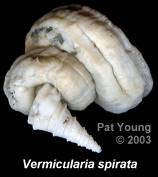 Some of the days more interesting items included a crocodile tooth (Andy Abdul), marlin beak (Sharron Edwards) and an extremely large ray spine (Barb Roder). Rocky Culbertson found an ecphora large than a soft ball at Block 26 and his friend an outstanding, jet black, Pungo myliobatis scute with three 'teeth' on it. Pat's big finds were a keyhole limpet (Diodora pamlicoensis) and another crab in matrix. John Everette, who is more noted for his fast walking the Yorktown, has finally joined the rest of us — today he plundered the Pleistocene and found a tiny (less than 1/2inch) Vermicularia spirata. Some of the days more interesting items included a crocodile tooth (Andy Abdul), marlin beak (Sharron Edwards) and an extremely large ray spine (Barb Roder). Rocky Culbertson found an ecphora large than a soft ball at Block 26 and his friend an outstanding, jet black, Pungo myliobatis scute with three 'teeth' on it. Pat's big finds were a keyhole limpet (Diodora pamlicoensis) and another crab in matrix. John Everette, who is more noted for his fast walking the Yorktown, has finally joined the rest of us — today he plundered the Pleistocene and found a tiny (less than 1/2inch) Vermicularia spirata.
|
|
Weekend 2 — Gone Fishing
Pat was away hunting wahoo during the second weekend and we'd hoped one of the visitors would provide details of the weekend's results, but alas ... Upon her return, she hooked up with Becky Hyne to provide details of that weekend. It was another double-day weekend for the Friends of the Museum and they had beautiful weather.
October 4th. Collecting was confined to Block 26A. Frank Blazich took home the megs of the day (3-3/4 & 2 inchers). Eric Fritz , Becky and John Everette each found Notorynchus lowers. Quite a few nice large 'makos' were found including those by Rita McDaniel, John Everette (2-7/16"), Pam Platt(2-1/4") and Sharron Edwards. The usual assortment of tigers, Hemis and Carcharhinus teeth were recovered. Rita found a billfish lower beak. Some of the more interesting finds included Squatina (Wayne Bowman), seal canine (George Powell) and 3 porpoise ear bones (David Wooten). Bird bones were found by George Powell and Frank Blazich (4).
October 5th. Carol Homon certainly brought home the weekend's best, a 14 point Hexanchus. Grady Frame found a Squalodon premolar, two 2" 'makos' and two very large Hemis. The only meg of the day was reported by George Powell who found a 2-5/8 inch Pungo tooth (there may have been others). Lots of tigers and 'makos' are still being found, many with exquisite colors. John Everette and Rick Bennett brought out nice ray dermal scutes. Rick and Sharron Edwards each found seal bones (Sharron's was a metacarpal). Becky and Sharron each found Notorynchus teeth, Rita McDaniel a tapir molar and Ron Edwards a piece of shark cartilage.
|
| September 30, 2003 |
|
Weekend 1 — Isabel's Bounty
Pat was unavailable to cover this weekend's experiences, but Tom Caggiano has stepped in to provide the "News". For those that don't know him, Tom is editor of the NJPS's Palaeontograph and a class act. He wrote:
The fall season opened with two beautiful sunny days. Saturday was very warm and humid and Sunday was less so. This trip was for Friends of the Museum. Curtis and the Board of Friends are working very hard to increase collecting opportunities in the mine. At this point we still cannot get access to "the pit", but we hope that will change in the future. Keep the faith and hope for the best. We are lucky to have them working for Friends and the clubs. Curtis is doing a great job; the museum looks great and seems full of activity.
The NCPC area is no longer available due to flooding and mine activity so we were left with Block 26A on Saturday and the smaller 26B on Sunday. A path was cut thru both with a bulldozer earlier, which served to stir things up a bit and this produced most of the larger items. I had very high hopes and expected to see teeth everywhere considering the hurricane that had just moved thru the area. I was wrong, but not too far off. I think everyone walked out happy.
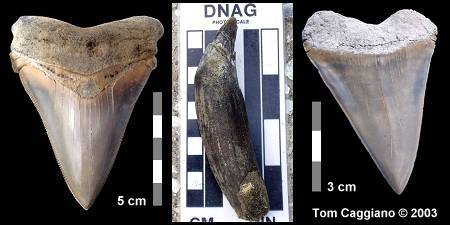
A good number of megs came out. I think Saturday produced six. I saw a 3-1/2" chubutensis by Brian Hempy of So. Carolina (ref above image - left and below). Brian also bagged a ray plate and a large whale tooth (ref above image - center). Dave Sanderson, also of SC, got a beautiful 4-incher. Cindy Munson got two Squalodons, one molar and one canine. That is all I saw of note.
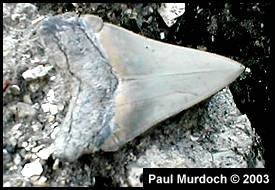 Megs were around on Sunday also, but all were small. Steve Balliet (NJPS) got his first (2-3/4"). Ramona Krailer popped a 2-incher out of a block of matrix and picked up another. She also got what is tentatively identified as part of a walrus tusk. Ron Edwards got a nice posterior meg and a sperm whale tooth, while wife Sharon got a small but complete sting ray barb and a piece that John Everette identified as 'part of a seal skull'. Brian Hempy had a 2-1/2 chubutensis and Bill Heim a pathologic (about 2") one. Eric Thompson found a 2-3/4 meg, a piece of fossil wood and a knuckle bone from something. As usual, George Powell was being a nice guy showing a newcomer the ropes and was rewarded by picking up a monster croc tooth while doing his good deed. He also picked up three Notorynchus during the day. Fred Ackerman was very happy with his first 'Bramble', which was right where George Powell said it would be; "If you want a Bramble, go to the right and near the end of the pile". Fred also got a couple of small megs and over a dozen porpoise teeth.
Megs were around on Sunday also, but all were small. Steve Balliet (NJPS) got his first (2-3/4"). Ramona Krailer popped a 2-incher out of a block of matrix and picked up another. She also got what is tentatively identified as part of a walrus tusk. Ron Edwards got a nice posterior meg and a sperm whale tooth, while wife Sharon got a small but complete sting ray barb and a piece that John Everette identified as 'part of a seal skull'. Brian Hempy had a 2-1/2 chubutensis and Bill Heim a pathologic (about 2") one. Eric Thompson found a 2-3/4 meg, a piece of fossil wood and a knuckle bone from something. As usual, George Powell was being a nice guy showing a newcomer the ropes and was rewarded by picking up a monster croc tooth while doing his good deed. He also picked up three Notorynchus during the day. Fred Ackerman was very happy with his first 'Bramble', which was right where George Powell said it would be; "If you want a Bramble, go to the right and near the end of the pile". Fred also got a couple of small megs and over a dozen porpoise teeth.
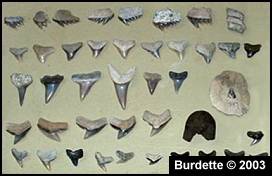 "Makos" were reported by almost everyone including myself, Mary Ellen Cole, Fred Ackerman and Chuck Ball (a 2-inch "chub" and a 2-1/2 inch "mako"). The great John Everette had everyone talking with his 3' "xiphodon" that was bigger than any of the megs and was the largest anyone had ever seen in recent memory (ref above image - right). John Pascall got a nice dermal scute and a small C. carcharias. Paul Murdoch had two Squalodons. Mike Folmer picked up a beautiful little seal molar and a 4" whale tooth. Debby Burdette had a partial Hexanchus, five Notorynchus and two barracuda teeth (ref adjoining). Becky also had a barracuda, a nice Hexanchus and a Squatina. It was good to see her out there and able to smile after the recent loss of Frank. He will be missed.
"Makos" were reported by almost everyone including myself, Mary Ellen Cole, Fred Ackerman and Chuck Ball (a 2-inch "chub" and a 2-1/2 inch "mako"). The great John Everette had everyone talking with his 3' "xiphodon" that was bigger than any of the megs and was the largest anyone had ever seen in recent memory (ref above image - right). John Pascall got a nice dermal scute and a small C. carcharias. Paul Murdoch had two Squalodons. Mike Folmer picked up a beautiful little seal molar and a 4" whale tooth. Debby Burdette had a partial Hexanchus, five Notorynchus and two barracuda teeth (ref adjoining). Becky also had a barracuda, a nice Hexanchus and a Squatina. It was good to see her out there and able to smile after the recent loss of Frank. He will be missed.
|
| September 24 2003 |
|
Slots have been Awarded
For a while there, it seemed like a fall collecting season might be in jeopardy. However, it does look like there'll be one. It should be starting this coming weekend (Sep 27) with Friends of the Museum members. They'll have collecting priority through mid-October when slots will be available to clubs and other 'non-members'.
The allocation of 'slots' to various clubs has been significantly cut. The NJPS (my club of record) for example, was awarded only eight slots (Oct 26) this year. The pit will again be closed to collecting, so it's back to Block 26.
I'd like to encourage others to participate in the Lee Creek News. Pat's reporting is terrific, but personal perspectives and images of interesting finds do add depth to the News.
|
| August 23 2003 |
|
The Upcoming Season
Well, I was contacted by Curtis Ormond who said they're planning for a Fall season. The actual collecting area has not yet been established, it could be the same as last spring or different. For those clubs interested, he wrote, "I will be taking applications until the end of August and plans are to have everyone
notified by the middle of September." He went on to note that the first 170 (or so slots) would go to "The Friends of the Museum".
|
|
|